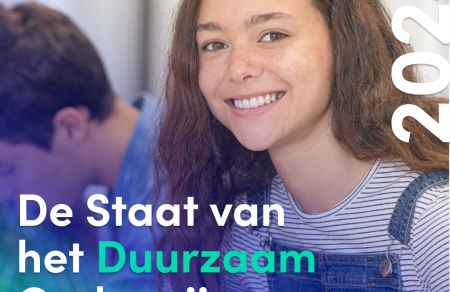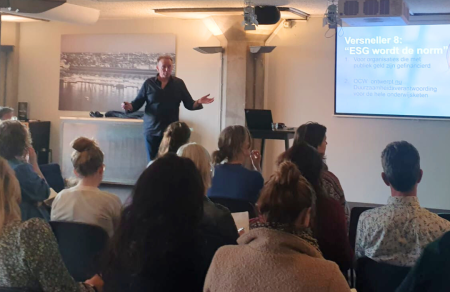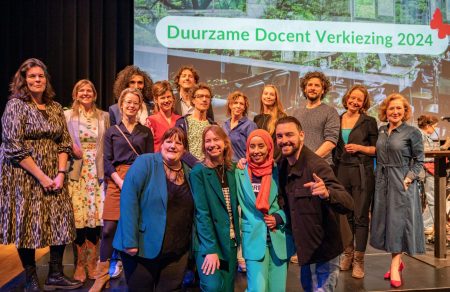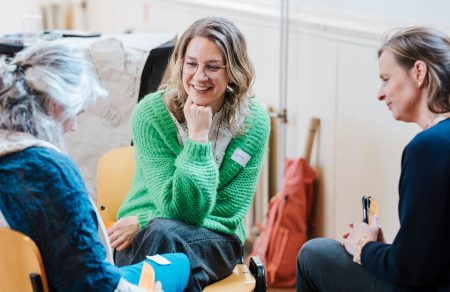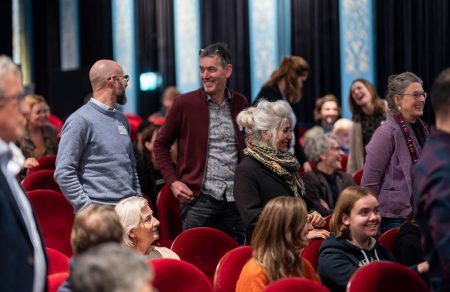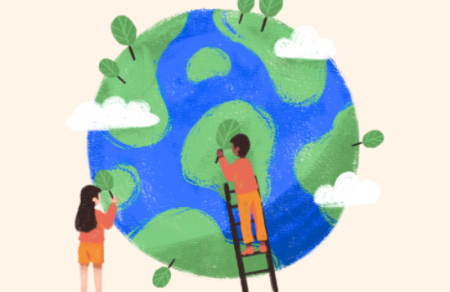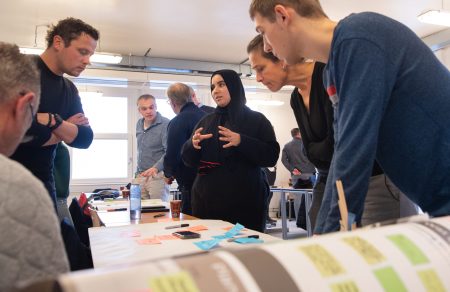Reviewers: Chris Maas Geesteranus (VVM) and André de Hamer (Sustainable PABO).
Authors: Martin de Wolf, Eefje Smit and Peter Hurkxkens
Publisher Garant, Antwerp-Apeldoorn, 2018
1. This book is the third, revised edition of the book of the same name published in 2011. The changes are mainly in the greater focus of the themes that are addressed, in the concretization of the didactic principles and their effects on practice. The somewhat fragmented structure of the first book 'was for the authors of this book [the 2011 version - CMG] reason to produce a book, describing education about sustainable development as a coherent whole'they write in the introduction. And after reading the revised version from 2018, you can conclude that the book does what it promises: it ís coherent, in terms of content and as a learning process. With which we would like to give the authors a clear compliment.
2. Who is this book intended for and what exactly is it about? It is only on page 172 that it becomes really clear who exactly the book is intended for: for teachers in upper primary education, teachers in secondary education and teachers in vocational education; and also for all these teachers in training. In our opinion, this should have been stated immediately in the introduction.
And what exactly are teachers supposed to do with it? Fortunately, that's what the introduction says: "We hope that this book can give (prospective) teachers good ideas for designing and implementing education on sustainable development.
The listing of reasons why things must and can be done differently, in the first chapter, uses a prioritization that seems peculiar and somewhat outdated in the year 2019. Climate change and biodiversity loss dominate the news, but climate change is listed as the third reason and biodiversity collapse is not mentioned as a reason (see also point 6).
3. The format of the book is as follows. Chapter 1 contains the introduction of the concept of sustainable development, why it is needed and on its position in education. Chapters 2 to 4 describe three necessary thinking skills: systems thinking (h. 2), multi-perspective thinking (h. 3) and solution and future-oriented thinking (h. 4). In chapter 5, the authors present their views on the educational design process and the reader is challenged to ask various questions about that design process and the resulting didactic approach.
At the end of each chapter, the reader will find a number of concrete methods for use in the group/class and a few assignments; the latter can be used in the 'application, analysis and evaluation' of what has been read. We would have preferred to see the assignments on a matching (open) website: that would have given more space in the book for illustrations. Moreover, the assignments can be elaborated, supplemented, and updated on a website.
4. What surprises us particularly positively in this approach is the firm focus on moral questions; or, ethics (paras. 3.1 and 3.2). This means that the authors clearly want to indicate that knowledge and skills in issues of sustainability are not enough. What is only missing is the systematic approach to it: how to deal with ethical questions in group or class, without forcing opinions, visions and beliefs on pupils and students? It is a pity then that the existing literature on the subject is not used. We mention in this context the practical booklet Environmental Ethics (Vromans et al., z.j. Environmental Ethics. HAS 's-Hertogenbosch. The following from chapter 7 has been taken from it; the relevant chapter on the step-by-step plan (7) was written by Rob de Vrind, leader of the Sustainable MBO organization):
———————————————————————————————————
7.2. A roadmap for sustainable decision-making
Considering the book [the authors are referring here to the book 'Cradle to Cradle' by Braungart and McDonough (2002) - CMG] ... you would then arrive at the following roadmap to make a sustainable decision.
STEP 1 ANALYSIS
Briefly describe the situation. See what the facts are and postpone judgment:
- Who are involved in the situation?
- Stand in the shoes of those different people and see what interests they have individuals on the people, profit and planet front? Include also the long term consequencesmine and possible consequences for the developing world.
STEP 2 WEIGHTING
What solution would the various stakeholders come up with:
- What are the advantages and disadvantages of the different solutions?
- What is common in the solutions
- What do the principles of our rule of law say as the precautionary principle, the "polluter pays" principle and principle of good neighborliness?
- What do resource ethics, nature ethics, and the ethics of sustainable development say?
- What does the principle of sustainable development (PPP) and of cradle to cradle say?
- Now come to a decision, a compromise, and consider whether damage is compensable.
STEP 3 JUSTIFICATION
- Could you tell the choice freely to everyone?
- Would people who are great moral role models come to the same decision?
- Would you also come to that decision if it affected your friends or family?
- Would you be OK if the choice affected yourself?
- Does the choice go against your own values? What does your conscience say?
- Does the choice go against laws and regulations?
- Does the choice go against the rules of your profession, the institution or the company?
If one wants to understand this approach (much) more extensively, we refer to the classic 1990 work, 'Look, the kaleidoscope moves. Choices for value-forming nature and environmental education' .
————————————————————————————————————
5. The book by Martin de Wolf et al. appears to be the first educational design book in the field of sustainable development that takes the SDGs as its starting point. On the one hand, this is very useful because it finally gives the concept of "sustainable development" - at least in educational circles - hands and feet. After all, the concept is broken down into the 17 goals that make up the SDGs. On the other hand, it must then become clear how these goals, of course in context, are used: both in the design phase of lessons and in educational practice.
They certainly come up in the examples but unfortunately the explanation of that connection is completely missing. In short, it is not clear how they use the SDGs. As far as we are concerned, this is a missed opportunity, because who does not complain about the unmanageability of the concept of 'sustainable development' or 'sustainability' as such?
6. The core of the themes is about the balanced use of resources: human and natural. It is notable that natural resources are only about what you can extract from or from the Earth.
What it does not deal with - and in our opinion at least as important - are the natural, renewable, "resources" that are, hidden or not, in the major ecosystems of the Earth. As a result, the book does not address coherence, diversity and changes in ecology , ecosystem functioning and so-called ecosystem services as described in the Millennium Ecosystem Assessment (See www.millenniumassessment.org/en/index.html). By this we mean that the use of natural resources is also strongly dependent on the continued functioning of those ecosystems. And that should have had a place in this book.
7. The themes are - fortunately - diverse and all formulated in such a way that they carry global aspects: flowers from Kenya, clothes from Bangladesh, climate, energy, tropical rainforest. This immediately raises the issue of our own relationship with such issues. Because we have the idea that in the Netherlands sustainability is currently primarily interpreted as securing one's own environment. In the Netherlands we ask ourselves far too little about the extent to which we can help make life better elsewhere in the world (socio-economically, ecologically, power relations in trade, etc.). And that is what this book does. But what is missing is the idea of using biomimicry in the field to gain insight into the solutions that 'nature' has been able to find for all sorts of problems over a couple of billion years. As recent years have shown, we would learn a great deal from this in understanding issues in the field of sustainability.
8. The key question in all of this is: can you ask this extensive and complex approach of a teacher when designing curriculum? If he designs at all ....... Our answer is: no, not without question. Reading the book, interpreting it to one's own situation, working on one's own design and methodology system seems to us, all in all, to be very tough and extremely time-consuming for the practicing teacher. Certainly not impossible, but very demanding. Do teachers even have time for that?
We therefore think that this book would be an excellent subject for a refresher course in designing teaching programmes on sustainable development, or for a refresher course in teaching methods. And, of course, it could be used in PABO's and other teacher training courses, as well as in the learning circles of the NME Network. The teacher competences for sustainability already mentioned in the book could play an important role here.
9. The design of the book is very austere. This will have been a choice of the publisher but is a pity in our opinion. Moreover, a black and white design has been chosen which makes some of the photos stand out, such as the satellite image of flower farms around Lake Naivasha in Kenya (page 58). Speaking of photos, the balance between photos and figures could have been more balanced, with more photos (or drawings) in particular. For example, from page 91 to page 103, there is not a single photograph opposite three graphics. This makes the book unnecessarily less attractive.
10. Important in any book that expects something from the reader is the bibliography. It is extensive but unfortunately lacks a number of Dutch and foreign works of the last decades. We mention, apart from the literature already mentioned in footnotes:
- Akker, J.J.H. van den, 1988.
Design and implementation of nature education. Thesis University of Twente. Swets & Zeitlinger b.v., Amsterdam/Lisse.
- Alblas, Art, 1999.
Teaching for a nature-involved existence. Didactic principles for nature and environmental education. Thesis Wageningen University.
- Biesta, Gert, 2018.
Time for pedagogy. On the pedagogical paragraph in education, training and formation. Inaugural address, University for Humanistics, Utrecht.
- Bleijerveld, Kees and Jan Greven, 1994.
Basic Document NME. A draft for the content of Nature and Environmental Education in Primary Education. SLO, Enschede.
- Breiting, SØren, Michela Mayer und Finn Mogensen, 2005.
Qualitätskriterien für BNE-Schulen. Bildung für Nachhaltige Entwicklung in Schulen - Leitfaden zur Entwicklung von Qualitätskriterien. Bundesministerium für Bildung, Wissenschaft und Kultur Ref. V/11c, Umweltbildung, Wien.
- Brunner, Wolfgang, Shepherd Urenje et al, 2012.
The Parts and the Whole. A Holistic Approach to Environmental and Sustainability Education. 2 Vol. Swedish International Centre of Education for Sustainable Development, Visby.
- Delhaas, Ruud J., Herbert H.M. Koekkoek and Trijnie N. Akkerman, 1990.
Look, the kaleidoscope moves. Choices for value-forming nature and environmental education. 2 Dln. University Teacher Training in Biology, rijksuniversiteit Groningen.
- Frijters, Stan, 2016.
Learning for Sustainable Development. Just do it. Stoas Wageningen/Vilentum University of Applied Sciences.
- Gerritsma, Henk (ed.), 1984.
The school in the world, the world in school. The Horstink, Amersfoort.
- Greven, Jan, 1995.
Basic Goals NME. Nature and Environment Education in Primary Education. SLO, Enschede.
- Hammer, André de and Peter Heres (ed.), s.j.
32 lessons for the future. idea & value, Hilversum.
- Jansen, Petra and André de Hamer (ed.), 2008.
Sustainable development in elementary school. Practical and didactic handbooks. Sustainable PABO and Veldwerk Nederland.
- Janssen, Fred, 1993.
Caring for nature. An ethical, psychological and didactic foundation. Department of Didactics of Biology, Utrecht University.
- Jickling, Bob, 1992.
Why I Don't Want My Children To Be Educated for Sustainable Development. Journal of Environmental Education 23(1992)4.
- Maas Geesteranus, C., 2019.
Shoring up nature and environmental education in new ways. Environment 25(2019)2.
- Poeck, K. Van and J. Loones (ed.), 2010.
Education for Sustainable Development: The flag and the charge. Flemish Government, Department of Environment, Nature and Energy, Brussels.
- Poeck, Katrien Van, Leif Östman and Johan Öhman (eds.), 2019.
Sustainable Development Teaching. Ethical and Political Challenges. Routledge, Abingdon.
- Rossen, Judy van, 1995.
Conceptual Analysis in Environmental Education: Why I Want My Children To Be Educated For Sustainable Development. Australian Journal for Environmental Education 11(1995).
- Scoullos, M. and V. Malotidi, 2004.
Handbook on Methods used in Environmental Education and Education for Sustainable Development. MIO-ECSDE, Athens.
- Sterling, Stephen, 2002.
Sustainable education. Re-visioning Learning and Change. Repr. Schumacher Briefing No. 6. Green Books.
- Sterling, Stephen et al, 2005.
Linkingthinking: new perspectives on thinking and learning for sustainability. Resource material. WWF Scotland, Aberfeldy .
- Webster, Ken, 2004.
Rethink, Refuse, Reduce ..... Education for sustainability in a changing world. Occasional Publication 89. FSC, Preston Montford.

